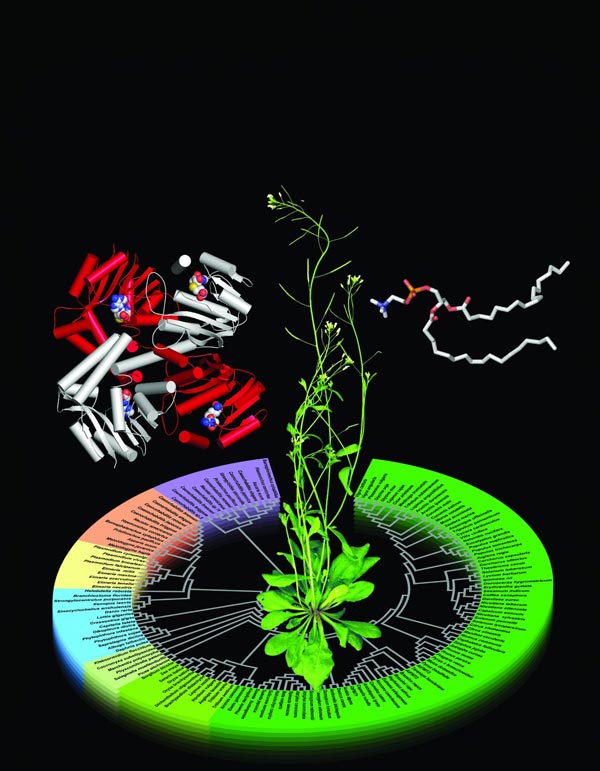A phospholipid pathway from plants to parasites

These are 3-D structures of Arabidopsis phosphoethanolamine methyltransferase (PMT) and phosphatidylcholine, with evolutionary relationships of PMT sequences from different organisms. Credit: Soon Goo Lee and Joseph Jez
Choline is an essential nutrient that humans get from certain foods, including eggs, meat, leafy greens and nuts. The human body converts choline into phosphocholine (pCho), which it in turn converts into (among other essential building blocks) phosphatidylcholine (PtdCho), a component of cell membranes.
Plants, however, can't acquire the nutrient from the environment and so must synthesize pCho from scratch. The biochemical pathway plants use to synthesize pCho is also found in nematodes and the malaria parasite Plasmodium.
In plants, the enzymatic reaction that produces pCho is essential for both normal function and for responding to stresses. Plant pCho is converted into PtdCho, which builds membranes that can adjust their rigidity in response to temperature changes. Plant pCho also gets converted into molecules that help the plant survive high salt. The enzymes that produce plant pCho are called called phosphoethanolamine methyltransferases (PMTs).
Soon Goo Lee, a postdoctoral research fellow at Washington University in the laboratory of Joseph Jez (who is also an associate editor of the Journal of Biological Chemistry), has been fascinated by PMTs in both plants and parasites for many years.
“Understanding the PMT enzyme is key to engineer plants with improved stress tolerance and enhanced nutrients,” Lee said. Furthermore, since the PMT-catalyzed pathway is found in parasites but not humans, Lee and Jez's team is looking for inhibitors of this enzyme to treat diseases caused by these parasites.
The new study explains how PMTs of the model plant Arabidopsis thaliana share core features of parasite PMTs, with almost identical structure at the active site. But the plant PMTs are roughly twice as large as the parasite ones, with large sections that can rearrange themselves to carry out multiple chemical reactions.
Furthermore, the three PMT types found in the plant – which were thought to carry out the same function – actually appear to play different roles depending on where they are found in the plant. Plant growth experiments showed that one type of PMT was essential for root development and salt tolerance, whereas the other two had no effect on roots and instead seemed to be found primarily in leaves.
In the long run, this big-picture view of PMTs in different organisms offers routes to precisely engineer enzymes with different functions.
“I love these kinds of stories, where I can look from the atomic [structure] to the physiological level to explain why these enzymes have different forms and how they work,” Lee said.
###
The work was funded by the National Institutes of Health.
About the Journal of Biological Chemistry
JBC is a weekly peer-reviewed scientific journal that publishes research “motivated by biology, enabled by chemistry” across all areas of biochemistry and molecular biology. The read the latest research in JBC, visit http://www.
About the American Society for Biochemistry and Molecular Biology
The ASBMB is a nonprofit scientific and educational organization with more than 12,000 members worldwide. Most members teach and conduct research at colleges and universities. Others conduct research in various government laboratories, at nonprofit research institutions and in industry. The Society's student members attend undergraduate or graduate institutions. For more information about ASBMB, visit http://www.
Media Contact
All latest news from the category: Life Sciences and Chemistry
Articles and reports from the Life Sciences and chemistry area deal with applied and basic research into modern biology, chemistry and human medicine.
Valuable information can be found on a range of life sciences fields including bacteriology, biochemistry, bionics, bioinformatics, biophysics, biotechnology, genetics, geobotany, human biology, marine biology, microbiology, molecular biology, cellular biology, zoology, bioinorganic chemistry, microchemistry and environmental chemistry.
Newest articles

Combatting disruptive ‘noise’ in quantum communication
In a significant milestone for quantum communication technology, an experiment has demonstrated how networks can be leveraged to combat disruptive ‘noise’ in quantum communications. The international effort led by researchers…

Stretchable quantum dot display
Intrinsically stretchable quantum dot-based light-emitting diodes achieved record-breaking performance. A team of South Korean scientists led by Professor KIM Dae-Hyeong of the Center for Nanoparticle Research within the Institute for…

Internet can achieve quantum speed with light saved as sound
Researchers at the University of Copenhagen’s Niels Bohr Institute have developed a new way to create quantum memory: A small drum can store data sent with light in its sonic…





















